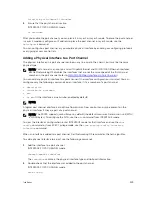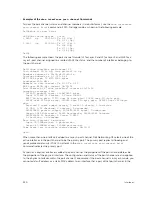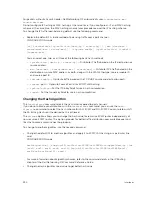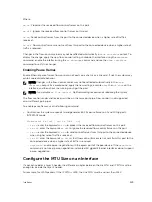
•
c
— Clear screen
•
a
— Page down
•
q
— Quit
Dell#monitor interface Te 3/1
Dell uptime is 1 day(s), 4 hour(s), 31 minute(s)
Monitor time: 00:00:00 Refresh Intvl.: 2s
Interface: Te 3/1, Disabled, Link is Down, Linespeed is 1000 Mbit
Traffic statistics: Current Rate Delta
Input bytes: 0 0 Bps 0
Output bytes: 0 0 Bps 0
Input packets: 0 0 pps 0
Output packets: 0 0 pps 0
64B packets: 0 0 pps 0
Over 64B packets: 0 0 pps 0
Over 127B packets: 0 0 pps 0
Over 255B packets: 0 0 pps 0
Over 511B packets: 0 0 pps 0
Over 1023B packets: 0 0 pps 0
Error statistics:
Input underruns: 0 0 pps 0
Input giants: 0 0 pps 0
Input throttles: 0 0 pps 0
Input CRC: 0 0 pps 0
Input IP checksum: 0 0 pps 0
Input overrun: 0 0 pps 0
Output underruns: 0 0 pps 0
Output throttles: 0 0 pps 0
m - Change mode c - Clear screen
l - Page up a - Page down
T - Increase refresh interval t - Decrease refresh interval
q - Quit
q
Dell#
Maintenance Using TDR
The time domain reflectometer (TDR) is supported on all Dell Networking switch/routers.
TDR is an assistance tool to resolve link issues that helps detect obvious open or short conditions within
any of the four copper pairs. TDR sends a signal onto the physical cable and examines the reflection of
the signal that returns. By examining the reflection, TDR is able to indicate whether there is a cable fault
(when the cable is broken, becomes unterminated, or if a transceiver is unplugged).
TDR is useful for troubleshooting an interface that is not establishing a link; that is, when the link is
flapping or not coming up. TDR is not intended to be used on an interface that is passing traffic. When a
TDR test is run on a physical cable, it is important to shut down the port on the far end of the cable.
Otherwise, it may lead to incorrect test results.
NOTE: TDR is an intrusive test. Do not run TDR on a link that is up and passing traffic.
To test and display TDR results, use the following commands.
1.
To test for cable faults on the TenGigabitEthernet cable.
EXEC Privilege mode
Interfaces
339
Summary of Contents for Z9000
Page 1: ...Dell Configuration Guide for the Z9000 System 9 7 0 0 ...
Page 80: ...grub reboot 80 Management ...
Page 128: ... 0 Te 1 1 Te 1 2 rx Flow N A N A 128 Access Control Lists ACLs ...
Page 491: ...Figure 70 Configuring OSPF and BGP for MSDP Multicast Source Discovery Protocol MSDP 491 ...
Page 496: ...Figure 73 MSDP Default Peer Scenario 1 496 Multicast Source Discovery Protocol MSDP ...
Page 497: ...Figure 74 MSDP Default Peer Scenario 2 Multicast Source Discovery Protocol MSDP 497 ...
Page 498: ...Figure 75 MSDP Default Peer Scenario 3 498 Multicast Source Discovery Protocol MSDP ...
Page 760: ...Figure 100 Single and Double Tag TPID Match 760 Service Provider Bridging ...
Page 761: ...Figure 101 Single and Double Tag First byte TPID Match Service Provider Bridging 761 ...
















































